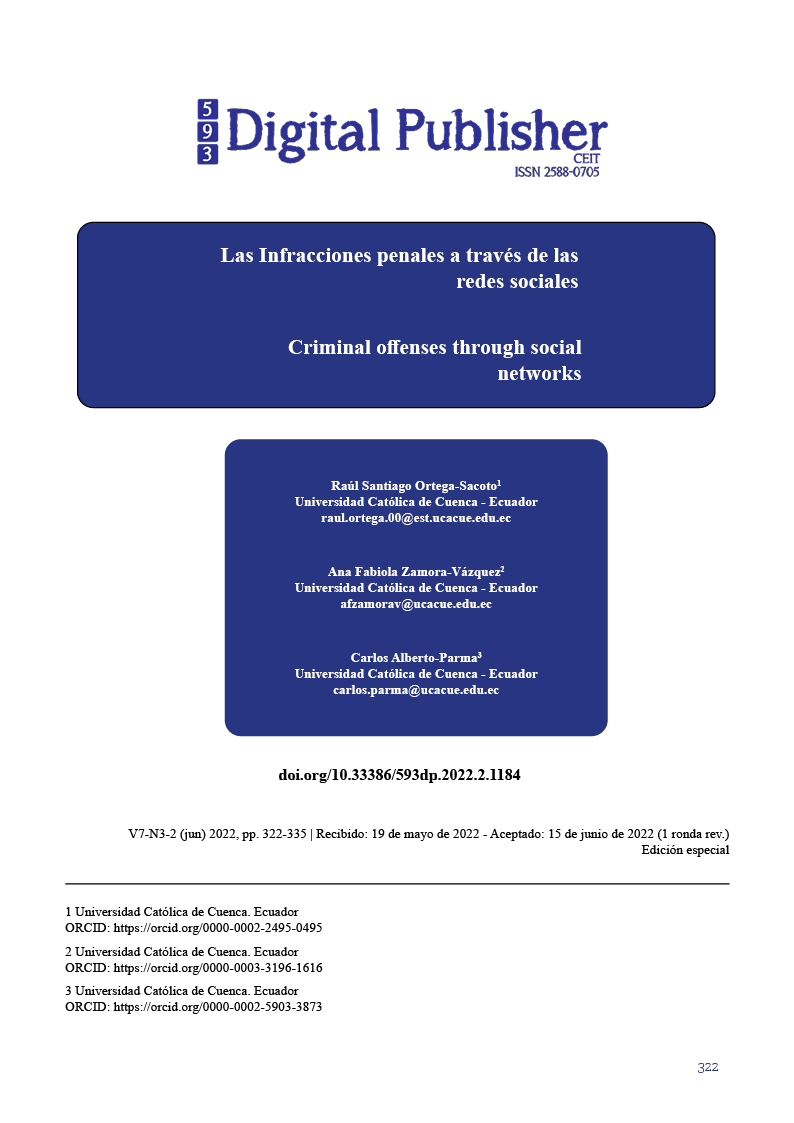Criminal offenses through social networks
Main Article Content
Abstract
Currently, social networks allow people to learn and interact with others directly and immediately. Through them, personal interrelationships are produced cybernetically, without the need for physical contact, and even, it is not necessary to know each other. This leads to the massive use of social networks and to the fact that several subjects spend a lot of time browsing through electronic devices such as cell phones and computers in their vast majority.
When entering social networks, users provide information of a personal nature and are in a state of violation of their image, photographs, information and personal data found in the profiles of the different existing social networks, therefore, it allows others people, who commit crimes through social networks, which, for the most part, go unpunished for not being able to identify the author of a criminal offense. The objective of this project is to determine the need to determine the need to incorporate into the Comprehensive Criminal Organic Code, what refers to the infractions committed through social networks. The methodology that we propose is descriptive with a qualitative approach, which was carried out through a bibliographic review and scientific journals, in order to obtain the information. we accessed several databases, such as: Scielo, Scopus, Google Scholar, Dialnet and Redalyc; With the data obtained, we used an analysis of a socio-legal nature within the Ecuadorian legal system. In conclusion, we establish the need to incorporate into the Ecuadorian legal system, a special regulation that regulates criminal offenses that are committed through social networks, so that they do not go unpunished and the perpetrator of the crime receives a sanction.
Downloads
Article Details

This work is licensed under a Creative Commons Attribution-NonCommercial-ShareAlike 4.0 International License.
1. Derechos de autor
Las obras que se publican en 593 Digital Publisher CEIT están sujetas a los siguientes términos:
1.1. 593 Digital Publisher CEIT, conserva los derechos patrimoniales (copyright) de las obras publicadas, favorece y permite la reutilización de las mismas bajo la licencia Licencia Creative Commons 4.0 de Reconocimiento-NoComercial-CompartirIgual 4.0, por lo cual se pueden copiar, usar, difundir, transmitir y exponer públicamente, siempre que:
1.1.a. Se cite la autoría y fuente original de su publicación (revista, editorial, URL).
1.1.b. No se usen para fines comerciales u onerosos.
1.1.c. Se mencione la existencia y especificaciones de esta licencia de uso.
References
Albán, J. P. (2016). Regulación de Internet y derechos digitales en Ecuador. Quito: Universidad San Francisco de Quito.
Alonso, E. C. (2009). “La información en la red y el principio de neutralidad tecnológica: la libertad de expresión y la difusión de información administrativa. España: Revista de Derecho del Estado.
Asamblea General de la ONU. (1948).
Bajovic, L. (2003). Sao to Sao. Turan: Modern.
Barriuso, R. C. (2009). Las redes sociales y la protección de datos hoy. Madrid: Universidad de Alcalá.
Brown, L. (2012). Delitos Modernos. Bogotá: Labianda.
Celaya, J. (2008). La Empresa en la WEB 2.0. . España: Grupo Planeta.
Chawki, M. (2015). Cybercrimen, digital forensics and jurisdiction. New York: Springer International.
Código Orgánico Integral Penal. (2014). Quito.
Constitución de la República del Ecuador. (2008). Quito.
Convención Americana Sobre Derechos Humanos. (1968).
Convención de las Naciones contra la Delincuencia Organizada Transnacional. (15 de noviembre de 2000).
Elizalde, M. (2010). Redes social. El rol del Estado en su regulación. Tres modelos: Argentina, Estados Unidos de Norte América y la Comunidad Europea. Obtenido de https://abogados.com.ar/redes-sociales-elrol-del-estado-en-su-regulacion/6058.
Ferrajoli, L. (2004). Derechos y garantías: la ley del más débil. Madrid: Trotta.
Girón, P. J. (2013). Teoría del delito. Guatemala: Instituto de la Defensa Pública.
Gozzer, S. (2011). Desafíos Tecnologicos. Lima: Del Sur.
Holt, K. (2010). Los delitos modernos. Sevilla: Modern.
Koops, M. (2012). Crimen Of Low. Bogotá: New Horizont.
Mehan, C. (2006). Los delitos de la información. Bogotá: Limfao.
Mehan, J. E. (2014). Cyberwar, Cyberterror, Cybercrime and Cyberactivism”. Ucrania : Governance Publishing; Second Edition.
Miro, L. F. (2013). Derecho penal, cyberbullying y otras formas de acoso (no sexual) en el ciberespacio. Madrid: Revista de Estudios de Derecho y Ciencia Política.
Naciones Unidas. (1966). Pacto Internacional de Derechos Civiles y Políticos. Resolución 2200 A (XXI).
Neto, L. (2009). Teoria del Delito Actual. Sevilla.: Lubis.
Páez Rivadeneira, J. (2010). Derecho y TICS. Quito: Coorporación de Estduis y Publicaciones.
Parker, D. (2016). Applications of criminological theory to cybercrimes. New York : British Library Cataloguing in Publication Data.
Picotti, L. (2013). Los derechos fundamentales en el uso y abuso de las redes sociales en Italia: aspectos penales. Italia: Revista de Estudios de Derecho y Ciencia Política.
Publimetro. (2012). Justicia no sabe qué hacer con casos de injuria y calumnia en Internet. Obtenido de : http://www.publimetro.co/vida-con-estilo/justicia-no-sabe-que-hacer-concasos-de-injuria-y-calumnia-en-internet/lmklgj!yP0puYfflFdyY/
Ramírez y Zwerg, A. F. (2012). Metodología de la investigación, más que una receta.
Rico, C. M. (2012). El impacto de Internet y las redes sociales en el derecho a la libertad de expresión. Bogotá: Fronesis Revista de Filosofía Jurídica, Social y Política.
Roxin, C. (2001). Derecho penal, parte general, fundamentos. La estructura de la teoría del delito, . Madrid: Civistas.
Sanz, R. P. (2014). Redes sociales y derecho penal. España: Universidad de Valladolid.
Soto, S. M. (2012). “El crimen on – line. Una mirada a la responsabilidad del proveedor del servicio de internet”. Colombia: Justicia Juris.
Tobón, F. N. (2014). Anotaciones sobre el delito de injuria. Obtenido de http://www.nataliatobon.com/uploads/2/6/1/8/26189901/capitulo2injuria.pdf
Turrini, E. (2010). A Pragmatic, Experiential Definition of Computer crimens. Heidelberg: Springer.
Von Liszt, F. V. (2007). Tratado de Derecho penal. Buenos Aires: Valletta.
Wall, D. (2001). Cybercrimes and the Internet. New York: Routledge.
Watts, D. (2003). Seis Grados de Seperación. La ciencia de las redes en la era del acceso. . New York: Norton.
Zúñiga, L. (2016). “El concepto de criminalidad organizada transnacional: problemas y propuestas. Cali: Revista Nuevo Foro Penal.




